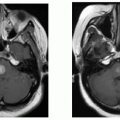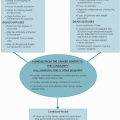Both epidemiologic studies and clinical management depend on an accepted, valid nomenclature for substance abuse and dependence. Unfortunately, this terminology is highly problematic. The pharmacologic phenomena of tolerance and physical dependence are commonly confused with abuse and true substance dependence as defined by
the DSM-IV (
Table 44.1), and the definitions applied to medical patients have been developed from experience with substance-abusing populations. The clarification of this terminology is an essential step in improving the diagnosis and management of substance abuse in the palliative care setting (
Table 44.2).
Tolerance
Tolerance is a pharmacologic property defined by the need for increasing doses to maintain effects (
19,
20). An extensive clinical experience with opioid drugs in the medical context has not confirmed that tolerance causes substantial problems (
21,
22). Although tolerance to a variety of opioid effects, including analgesia, can be reliably observed in animal models (
23), and tolerance to nonanalgesic effects, such as respiratory depression and cognitive impairment (
24), occurs routinely in the clinical setting, analgesic tolerance seldom interferes with the clinical efficacy of opioid drugs. Indeed, most patients attain stable doses associated with a favorable balance between analgesia and side effects for prolonged periods; dose escalation, when it is required, usually heralds the appearance of a progressive painful lesion (
25,
26,
27,
28,
29,
30,
31). Unlike tolerance to the side effects of opioids, clinically meaningful analgesic tolerance, which would yield the need for dose escalation to maintain analgesia in the absence of progressive disease, appears to be a rare phenomenon. Clinical observation also fails to support the conclusion that analgesic tolerance is a substantial contributor to the development of substance dependence.
Physical Dependence
Physical dependence is defined solely by the occurrence of an abstinence syndrome (withdrawal) following abrupt dose reduction or administration of an antagonist (
19,
20,
32). There is great confusion among clinicians about the differences between physical dependence and true substance dependence. Physical dependence, like tolerance, has been suggested to be a component of substance dependence (
33,
34), and the avoidance of withdrawal has been postulated to create behavioral contingencies that reinforce drugseeking behavior (
35). These speculations, however, are not supported by experience acquired during opioid therapy for chronic pain. Physical dependence does not preclude the uncomplicated discontinuation of opioids during multidisciplinary pain management of nonmalignant pain (
36), and opioid therapy is routinely stopped without difficulty in the patients with cancer whose pain disappears following effective antineoplastic therapy. Indirect evidence for a fundamental distinction between physical dependence and substance dependence is even provided by animal models of opioid self-administration, which have demonstrated that persistent drug-taking behavior can be maintained in the absence of physical dependence (
37).
Addiction
The terms addiction and addict are particularly troublesome. These labels are often inappropriately applied to describe both aberrant drug use (reminiscent of the behaviors that characterize active abusers of illicit drugs) and phenomena related to tolerance or physical dependence. The labels “addict” and “addiction” should never be used to describe patients who are only perceived to have the capacity for an abstinence syndrome. These patients must be labeled “physically dependent.” Use of the word “dependent” alone also should be discouraged, because it fosters confusion between physical dependence and psychological dependence, a component of substance dependence. For the same reason, the term habituation should not be used. It is recommended that the DSM-IV (
17) terms substance abuse and substance dependence be applied as appropriate.
Definitions of “substance abuse” and “substance dependence” must be based on the identification of drug-related behaviors that are outside of cultural or societal norms. The ability to categorize questionable behaviors (e.g., consuming a few extra doses of a prescribed opioid, particularly if this behavior was not specifically prescribed by the clinician, or using an opioid drug prescribed for pain as a nighttime hypnotic) as nonnormative presupposes that there is certainty about the parameters of normative behavior. In fact, even experienced pain clinicians disagree on the interpretation of varied drug-taking patterns. In a recent survey, pain clinicians expressed significant individual differences in the perception of which behaviors were the most problematic when asked to rank order a list of aberrant drug-taking behaviors (
38). In general, physicians rated illegal behaviors as the most aberrant, followed by alteration of the route of delivery and self-escalation of dose.
Unfortunately, there are few empirical data in medically ill populations that define the meaning of specific drugrelated behaviors in relation to substance-use disorders or future drug abuse; as a result, the boundaries of normative behavior remain ill defined. The confusing nature of normative drug taking was highlighted in a pilot survey performed in 2000 at MSKCC, which revealed that inpatients with cancer harbor attitudes supporting misuse of drugs in the face of symptom management problems and that women with human immunodeficiency virus (at MSKCC for palliative
care) engage in such behaviors commonly (
39). The prevalence of such behaviors and attitudes among the medically ill raises concern about their predictive validity as a marker of any diagnosis related to substance abuse. Clearly, there is a need for empirical data that illuminate the prevalence of drug-taking attitudes and behaviors in different populations of medically ill patients.
The core concepts used to define substance dependence also may be problematic as a result of changes induced by a progressive disease. Deterioration in physical or psychosocial functioning caused by the disease and its treatment may be difficult to separate from the morbidity associated with drug abuse. This may particularly complicate efforts to evaluate the concept of “use despite harm,” which is critical to the diagnosis of substance abuse or dependence. For example, the nature of questionable drug-related behaviors can be difficult to discern in the patient who develops social withdrawal or cognitive changes following brain irradiation for metastases. Even if impaired cognition is clearly related to the drugs used to treat symptoms, this outcome might only reflect a narrow therapeutic window, rather than a desire on the patient’s part for these psychic effects.
Definitions of Substance Dependence in the Medically III
Previous definitions that include phenomena related to physical dependence or tolerance cannot be the model terminology for medically ill populations who receive potentially abusable drugs for legitimate medical purposes. A more appropriate definition of substance dependence notes that it is a chronic disorder characterized by “the compulsive use of a substance resulting in physical, psychological, or social harm to the user and continued use despite that harm” (
40). Although this definition was developed from experience in substance-abusing populations without medical illness, it appropriately emphasizes that substance dependence is, fundamentally, a psychological and behavioral syndrome. Any appropriate definition of substance abuse or dependence must include the concepts of loss of control over drug use, compulsive drug use, and continued use despite harm.
Even appropriate definitions of substance dependence will have limited utility, however, unless operationalized for a clinical setting. The concept of “aberrant drug-related behavior” is a useful first step in operationalizing the definitions of substance abuse and dependence and recognizes the broad range of behaviors that may be considered problematic by prescribers. Although the assessment and interpretation of these behaviors can be challenging, as discussed previously, the occurrence of aberrant behaviors signals the need to reevaluate and manage drug taking, even in the context of an appropriate medical indication for a drug.
If drug-taking behavior in a medical patient can be characterized as aberrant, a “differential diagnosis” for this behavior can be explored. That a patient has a true substancedependent disorder is only one of several possible explanations. The challenging diagnosis of pseudoaddiction must be considered if the patient is reporting distress associated with unrelieved symptoms. In the case of pseudoaddiction, behaviors such as aggressively complaining about the need for higher doses and occasional unilateral drug escalations indicate desperation caused by pain and disappear if pain management improves.
Alternatively, impulsive drug use may indicate the existence of another psychiatric disorder, the diagnosis of which may have therapeutic implications. Patients with borderline personality disorder can express fear and rage through aberrant drug taking and behave impulsively and self-destructively during pain therapy. Passik and Hay (
41) reported a case in which one of the more worrisome aberrant drug-related behaviors, forging of a prescription for a controlled substance, was an impulsive expression of fears of abandonment, having little to do with true substance abuse in a borderline patient. Such patients are challenging and often require firm limit-setting and careful monitoring to avoid impulsive drug taking.
Similarly, patients who self-medicate for anxiety, panic, depression, or even periodic dysphoria and loneliness can present as aberrant drug takers. In such instances, careful diagnosis and treatment of these problems can at times obviate the need for such self-medication. Occasionally, aberrant drug-related behavior appears to be causally related to a mild encephalopathy, with confusion about the appropriate therapeutic regimen. This may be a concern in the treatment of the elderly patient. Low doses of neuroleptic medications, simplified drug regimens, and help with organizing medications can address such problems. Rarely, problematic behaviors indicate criminal intent, such as when patients report pain but intend to sell or divert medications.
These diagnoses are not mutually exclusive. A thorough psychiatric assessment is critically important, both in the population without a prior history of substance abuse and the population of known abusers, who have a high prevalence of psychiatric comorbidity (
42,
43).
In assessing the differential diagnosis for drug-related behavior, it is useful to consider the degree of aberrancy (
Table 44.3). The less aberrant behaviors (such as aggressively complaining about the need for medications) are more likely to reflect untreated distress of some type, rather than substance dependence-related concerns. Conversely, the more aberrant behaviors (such as injection of an oral formulation) are more likely to reflect true substance dependence. Although empirical studies are needed to validate this conceptualization, it may be a useful model when evaluating aberrant behaviors.







